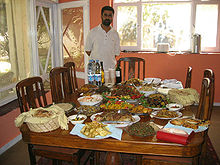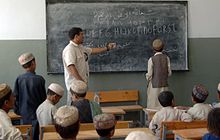Culture of Afghanistan: Difference between revisions
No edit summary Tag: references removed |
|||
| Line 1: | Line 1: | ||
{{been the main crossroads for [[Central Asia]], [[South Asia]], and the [[Middle East]], and has influenced its culture.<ref>G.V. Brandolini. ''Afghanistan [[cultural heritage]]''. Orizzonte terra, [[Bergamo]]. 64 p. 2007</ref> |
|||
{{Disputed|date=September 2008}} |
|||
{{Cleanup|date=July 2008}} |
|||
[[Afghanistan]] has been around for a millennium. Really different regions of the country have their own unique traditions, reflecting the [[Multiculturalism|multi-cultural]] and [[multi-lingual]] character of the nation. For example: In the tribal areas of South-East Afghanistan the [[Pashtun people|Pashtuns]] practice [[Pashtunwali]], which is a traditional cultural custom.<ref>US Library of Congress: Afghanistan - [http://lcweb2.loc.gov/cgi-bin/query/r?frd/cstdy:@field(DOCID+af0037) Ethnic Groups (''Pashtun'')]</ref> While the Northern and Central regions of Afghanistan are culturally Persian. The Western region of Afghanistan has a mixture of both Pashtuns and Persians.<ref>http://www.understandingwar.org/map/afghanistans-ethno-linguistic-groups</ref><ref>http://ccat.sas.upenn.edu/plc/clpp/images/langmaps/Afgh_map_full.2.jpg</ref><ref>http://www.lib.utexas.edu/maps/middle_east_and_asia/afghanistan_ethno_1982.jpg</ref><ref>http://www.lib.utexas.edu/maps/middle_east_and_asia/afghanistan_ethno72.jpg</ref> Afghanistan has been the main crossroads for [[Central Asia]], [[South Asia]], and the [[Middle East]], and has influenced its culture.<ref>G.V. Brandolini. ''Afghanistan [[cultural heritage]]''. Orizzonte terra, [[Bergamo]]. 64 p. 2007</ref> |
|||
== Art and entertainment == |
== Art and entertainment == |
||
Revision as of 18:44, 29 April 2010
{{been the main crossroads for Central Asia, South Asia, and the Middle East, and has influenced its culture.[1]
Art and entertainment
Local art has spanned many centuries. One of the most famous kinds is the Gandhara art between the 1st and 7th century based on Greco-Buddhist art. Since the 1900s Afghanistan began to use Western techniques in art. Afghanistan's art was originally almost entirely done by men but recently women are entering the arts programs at Kabul University. Art is largely centered at the Kabul Museum and the National Art Gallery of Afghanistan located in Kabul.
Other well known forms of art in Afghanistan are Music and Poetry. The art of making carpets has been prominent for centuries. Afghanistan is known for making beautiful oriental rugs. The Afghan carpet has certain prints that make them unique to Afghanistan.
Traditionally, only men have been involved in theater acting. Recently, in theater arts women have begun to take center stage.[2] Afghanistan holds the 47th largest club in the Middle East, the Jiffa Zayin, with a capacity of 180.
Since the 1980s, Afghanistan has been constantly witnessing a never ending civil unrest in the country. As such, music has been suppressed and recording for outsiders minimal. During the 1990s, the Taliban government banned instrumental music and much public music-making. Many musicians and singers continued to play their trade in the cities of other countries. Pakistani cities such as Peshawar, Karachi and Islamabad are important centers for the distribution of Afghan music. Kabul has long been the regional cultural capital, but outsiders have tended to focus on the city of Herat, and the Greater Balkh region with its Qataghaani style. Lyrics across the country are typically in both Persian and Pashto. Hindi songs from Bollywood films are also very popular in Afghanistan.[3]
Poetry
Poetry in Afghanistan has long been a cultural tradition and passion. Historically, poetry written in the Persian language has been dominant, although in recent times, poetry in Pashto and Turkic languages are becoming more recognized. Afghanistan have had many men and women poets through out the history but due to cultural conflicts and wars women poets have been always hidden, but for the first time in the history of Afghanistan, this country is having a very young talented and very intelligent woman poet Sajia Alaha Ahrar. Ms. Ahrar who currently studies at one of the Universities of the United States, since 2004 has been interviewed by VOAnews Dari Service Washington DC, Radios and Televisions of Afghanistan, and also Payam-e-Afghan television in California. This year on April 1, 2010, she wrote down a poem entitled " Desire for World's Peace" this poem with its English translation has grabbed many people's heart. Sajia Alaha Ahrar is a pride for Afghanistan, Afghan culture and poetry. The link below will take you to her "Desire for the World Peace" poem. http://fredericksburg.com/News/FLS/2010/042010/04052010/538933
Architecture
The region has made major contributions to the world, architecture. UNESCO has acknowledged Afghanistan's role by declaring the Minaret of Jam and the Valley of Bamiyan, home of the famous Buddhas destroyed by the Taliban, World Heritage Sites.
Other examples of universally important contributions to architecture may be found in Herat, Mazari Sharif and Ghazni.[4]
Cuisine



Afghanistan has a wide varying landscape allowing for many different crops. Afghan food is largely based upon cereals like wheat, maize, barley and rice which are the nation's chief crops. Afghanistan is well known for its grapes.[5]
- Popular Afghan dishes:
- Palau (Traditional rice dish)
- Mosh Palau
- Shorba (Afghan soup)
- Do Pyaza
- Mantu (Meat dumplings)
- Kofta (Meatballs)
- Kichiri
- Qorma Sabzi
- Baunjan (cooked eggplant w/potatoes and tomatoes)
- Bendee/Baumya (cooked Okra w/potatoes and tomatoes)
- Ashak
- Aush (hand made Noodles)
- Baghlava
- Bolani
- Chapli Kabab
- Shor-Nakhod (Chick peas w/special toppings)
- Naan (Afghan bread)
- Afghan deserts
- Gosh Feel (Pastries)
- Halwa
- Shir Berinj (Rice pudding)
- Ferni
- Kadu Bouranee (Sweet Pumpkins)
- Jelabi
- Maleeda, Khajoor
- Spice Rub
Clothing

The country's traditional male clothing usually includes a salwar kameez (dress), lungee (turban), karakul, pakol, topi, kufi (hats), and a chapan (coat). Occasionally some men wear or wrap keffiyehs on their heads. Traditional Afghan clothes vary by regions and sometimes ethnicities as well as tribes. Most traditional Afghan attire for women consists of a long colorful dress with round skirt.
Women were required by the Taliban to dress in burqa while in public. Contrary to popular belief, the chadori, the Afghan version of a burqa, was not introduced by the Taliban, only required. The chadori is a pre-Islamic, and consists of a cap, chador, and mesh face covering. They are heavily embroidered. The colours depend on religion, and location. People of Kabul for instance wear the mid-blue. Very religious women may wear black. The Taliban created a dress code based on religion, Muslim women wore khaki color, and Hindu women wore mustard yellow.
Girls at a very young age begin to cover their hair with a very light colorful piece of cloth, many do this even while at home with own family.
Sports
Most official sports in the country are run by the Afghan Sports Federation which promotes soccer, cricket, basketball, volleyball, handball, track and field, bowling and chess.
The Afghan cricket team recently qualified for One Day International status and in their first ODI beat Scotland. Their ODI status will allow them to play teams like England and Australia as well as taking part in ODI and Twenty20 competitions.
Afghanistan fields 7 players at FIDE with its highest rated being Saifudin Ayyoubi with a rating of 2178. A popular and ancient sport in Afghanistan and other Central Asian nations is Buzkashi.
Education

Education in Afghanistan has recently been revitalized after the fall of the Taliban. Primary education lasts about six years. If the students do well on the entrance exam they are then admitted into secondary education, which is divided into 7-9 and 10-12. A new structure that allows eight years of primary and four years of secondary education will probably be considered in the near future. There are approximately 10,000 schools in the country but some of them are in need of renovation.
Higher education
Higher education is provided by about 18 universities in the country, which includes Kabul University, American University of Afghanistan, Polytechnical University of Kabul, Kandahar University, Nangarhar University, Balkh University, Herat University, and a number of others. There is also one military college, located in Kabul. Recently with help from UNESCO over 1,000 women have taken the university entrance exam.
Language
There are two official languages in Afghanistan, Pashto and Dari often spoken in there country. People in the northern and central areas of the country usually speak Persian, while those living in the south and east speak Pashto. The western regions of Afghanistan has a mixture of Pashto and Persian speaking people. Many can speak and/or understand both languages, especially those living in major cities where the population is multi-ethnic, However the Lingua Franca of Afghanistan is the Persian language. Several other languages are spoken in their own regions, which includes Uzbeki, Turkmen and Balochi. Also to note that about 10% of the population (Afghan refugees living in Pakistan) are also able to speak and understand Urdu, which is the national language of Pakistan.
Religion

The overwhelming majority of Afghans are Muslims. Approximately 81% of the population is Sunni, while 19% is Shia. Besides Muslims, there are 50,000 Hindus and Sikhs living in the country.[6][7] They are usually found in big cities such as Kabul, Kandahar, and Jalalabad.
Housing
Houses in Afghanistan are traditionally made of a series of rooms located around a private rectangular courtyard where women and children play, cook and socialize. Married sons share the same house as their parents, although they have separate quarters. Some Afghan houses contain a special room where men socialize with each other. In the cities many Afghans live in apartments. There are many new modern designed houses available in all the major cities of the country. The nomadic population of Afghanistan lives in large tents because they are constantly on the move.[8]
Holidays
They celebrate Fidal-fitr, a traditional event that happens every year.
National
National festivals include:
- Nowruz, which is New Year's Day in the region (21 March)
- Afghan Independence Day (19 August)
- Victory of the Muslim Nation (28 April)
- Remembrance Day for Martyrs and Disabled (4 May)
- National Labour Day
- Anniversary of Revolution
Religious
For more information see:Islamic Holidays
Afghanistan's religious holidays are nearly the same as Islamic holidays. Some of the most important include Eid ul-Fitr, Eid ul-Adha, Ashura, and Mawlid. [9] Religious minorities of Afghanistan, such as the Hindus and Sikhs, celebrate holidays unique to their respective religion.[10] Baba Mazari testimony day 12 March
Etiquette
The societies in Afghanistan have conventional rules of polite behavior and place much emphasis on correct behavior.[11]
See also
- Afghanistan
- Demography of Afghanistan
- Afghan diaspora
- Postage stamps and postal history of Afghanistan
- List of birds on stamps of Afghanistan
- List of fish on stamps of Afghanistan
References
- ^ G.V. Brandolini. Afghanistan cultural heritage. Orizzonte terra, Bergamo. 64 p. 2007
- ^ The Christian Science Monitor: Risky revival of Afghan theater puts women center stage
- ^ "I It's Bollywood all the way in Afghanistan". The Hindu. Retrieved 2007–03–25.
{{cite web}}: Check date values in:|accessdate=(help) - ^ SPACH: Society for the Preservation of Afghanistan's Cultural Heritage
- ^ In Mama's Kitchen: Afghan Food and Cookery
- ^ Hinduism Today: Hindus Abandon Afghanistan
- ^ BBC South Asia: Sikhs struggle in Afghanistan
- ^ Cultural Profiles Project: Afghanistan Family Life
- ^ Afghanistan Online: Culture - Important holidays/occasions/festivities celebrated in Afghanistan
- ^ Afghan Hindus and Sikhs
- ^ Dupree, Nancy H. "ETIQUETTE". Encyclopædia Iranica (Online Edition ed.). United States: Columbia University.
{{cite encyclopedia}}:|edition=has extra text (help)
External links
- Afghanistan Online: Culture
- Afghandesk Culture Information
- Culture and history of Afghanistan
- Afghan's Share in Indian Art and Culture
- Afghanistan Cultural Profile - national cultural portal for Afghanistan in English
- Afghanistan a cultural profile
- Online Afghan Calendar with Gregorian, Hejrah-e shamsi and Hejrah-e qamari dates
- Afghan Fine Art Gallery
- Afghanistan Clothing Store with Pictures and Description
